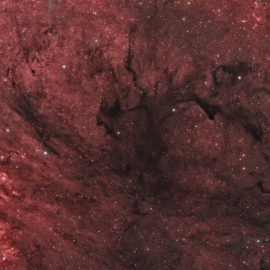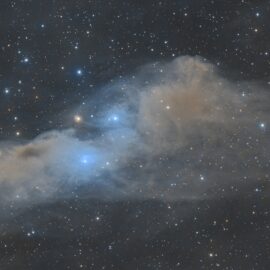IC342/Caldwell 5 – The Hidden Galaxy in LHaRGB
Planewave CDK 12.5in; AP 1100GTO AE; QHY600M, – Baader Cmos Opt Broadband and 6.5nm Ha Filters
L: (50 x 180s, Bin 1, Gain 100); H: (29 x 720s Bin 1, Gain 100); R,G,B: (25,23,22 x 210s, Bin 1, Gain 100)
Total integration time = 12.4 hrs (Feb 10-12, 2025) Maple Bay, BC, Canada
For full resolution, downloadable image, visit my gallery at Victoria RASC Zenfolio or Astobin
The Hidden Galaxy gets its name from its position in the sky, near the Milky Way and partly obscured by our galaxy’s dust. If not for the dust, IC342 would be visible with the naked eye and occupy about the same size as the moon.
In reality the galaxy is fairly large at 75 thousand light years across (half the diameter of Andromenda) and at 10 million light years away, about 4 times distant that either Andromeda or the Triangulum Galaxy. While not our neighbour, it is perphaps – across the street. It is not considered part of our local group of galaxies.
The galaxy is considered an :intermediate galaxy – nothing to do with its size, but because it isn’t barred, yet isn’t not barred at the same time. I will be adressing what causes a galaxy to be barred in a future post, but I believe it has to do with the amount and distribution of angular momentum of galactic hydrogen together with the mass ratio of the galaxy to its central black hole. It seems we do a much better job at categorizing things than explaining the categories.
There are few, if any, companion or dwarf galaxies associated with IC342 and this leaves its galactic structure relatively ideal and symmetric for a spiral. Despite its dusty veil, my Halpha filter managed to detect quite a few stellar nurseries around the spiral, including some that are unusually close to the galactic centre.
Two issues were encountered when imaging and processing this otherwise nice target. The first involves the dust that seems to impart a browning all over the image, and muting its natural colours – kind of like imaging through smoke. I tried to bring in more colour, but you can see the contrast with galactic images that aren’t taken through dust.
The other issue was the moon. There are few narrowband targets available at this time of year (February), and so galaxies with broadband filters is the the target of choice. These filters tend to capture sky gradients imposed by the moon, and I was only partially successful in removing them. You can see a bit of a gradient to blue from the bottom to the top of the image. Blue, happens to be the first colour that is lost when shooting through cosmic dust as well.



